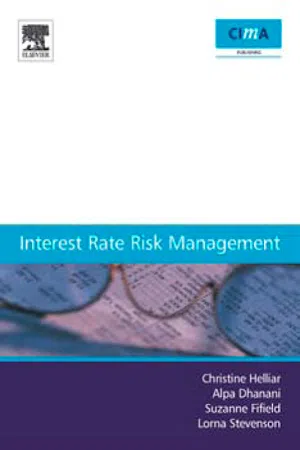Business
Interest Rate Hedge
An interest rate hedge is a financial strategy used by businesses to protect against the risk of interest rate fluctuations. It involves using financial instruments such as interest rate swaps or options to offset potential losses from changes in interest rates. By employing interest rate hedges, businesses can manage their exposure to interest rate movements and stabilize their financial position.
Written by Perlego with AI-assistance
Related key terms
1 of 5
3 Key excerpts on "Interest Rate Hedge"
- eBook - ePub
Derivatives
Theory and Practice
- Keith Cuthbertson, Dirk Nitzsche, Niall O'Sullivan(Authors)
- 2019(Publication Date)
- Wiley(Publisher)
CHAPTER 12 Hedging with Interest Rate FuturesAims- To examine how interest rate futures can be used for either hedging the value of fixed income assets (e.g. the dollar value of a portfolio of T-bills), or to ‘lock in’ future borrowing or lending rates (e.g. on existing floating-rate bank loans or deposits).
- To use the ‘price value of a basis point’ (PVBP) and the ‘duration-based hedge ratio’ to determine the optimal number of futures contracts to hedge a cash-market position in a fixed income asset (e.g. T-bills, bank loan, or bank deposit).
- To demonstrate the use of strip, rolling, and stack hedges.
We show how interest rate futures contracts allow investors to hedge spot positions in cash market assets, such as T-bills, bank deposits, and loans. Interest rate futures are a little more complex than futures on, say, stocks or oil. But the key thing to remember is that the price of any interest bearing asset (e.g. spot T-bill prices, interest rate futures prices) always moves in the opposite direction to the change in interest rates (yields). So, for example, when yields fall, the futures price will rise (and vice versa). The futures contracts we consider are the (90-day) T-bill and (90-day) Eurodollar contracts, where the change in futures prices depends on the change in a 90-day (forward) interest rate.Interest rate futures can be used to lock in a known ‘effective’ interest rate over a specific future time period. Consider the following situations:- It is 27 June. You have $10m in a (dollar) bank deposit which pays 180-day LIBOR. The next interest rate reset date is in about 6 months' time on 21 December. You fear a fall in interest rates over the next 6 months which means you will earn less interest on your deposits, when the (180-day) deposit rate is reset on 21 December.You can hedge this risk on 27 June, by going long (i.e. buying) a December-Eurodollar futures contract (which matures a few days after 21 December). If interest rates fall, the December-Eurodollar futures price will rise between June and December. You can then close out (i.e. buy back) your December-futures on 21 December at a higher price, making a cash profit on your futures trades, which can then be used to compensate for the lower interest rate you will receive on your bank deposit (from 21 December over the next 180 days).
- eBook - PDF
- Christine Helliar(Author)
- 2005(Publication Date)
- CIMA Publishing(Publisher)
Finally, economic exposure relates to future corpor-ate strategy, where the objective is to enhance competitiveness by maximising economic value over the long term (Belk and Glaum, 1990; Moffet and Karlsen, 1994). FX risk can be managed through the use of both internal and external hedging techniques. Internal hedging techniques are intended to reduce exposed positions, or prevent them from arising, and consist of techniques such as netting, matching, leading and lagging, pricing policies and asset/liability management (Buckley, 2000). By contrast, external hedging tech-niques can be undertaken through an intermediary, such as a bank or a dealer, and involve the use of derivatives including forwards, futures, options and swaps. A review of the literature indicates that many studies have exam-ined FX rate risk management, but there appears to be a dearth of work in the IRR management area (Bartram, 2002). A third research question that will, therefore, be examined in this study is whether IRR management or FX risk management is considered more impor-tant to the financial positions of UK companies. 2.6 Interest rate risk Interest rate risk is probably the most important of all the financial risks which organisations may face as there are several ways in which changes in interest rates can affect a business (Phillips, 1995). First, a company may have debt or bank overdraft finance linked to market interest rates such as the bank base rate or LIBOR 2 , and as interest rates change, the interest payable on these borrow-ings may also vary. A highly geared company, with a large amount of debt financing relative to equity capital, may suffer financial distress if interest rates increase dramatically. Second, a decrease in 2 London Interbank Offered Rate. 19 Interest Rate Risk Management interest rates will reduce the interest income for an organisation that has surplus cash invested in monetary deposits and floating-rate investments. - eBook - ePub
Introduction to Financial Mathematics
With Computer Applications
- Donald R. Chambers, Qin Lu(Authors)
- 2021(Publication Date)
- Chapman and Hall/CRC(Publisher)
• tend to have lower transaction costs • tend to have lower margin requirement • tend to be more liquidAssume that a portfolio manager is concerned about interest rate risk in the next six months. The manager can use bond/interest rate futures with six months to settlement to hedge. The portfolio manager can always roll over the hedge if needed as part of a continued hedge. Since the manager cares about the interest rate risk at the end of the maturity of the futures contracts, it is easier to model all durations as of the end of the futures maturity.Consider two portfolios: Portfolio P is a portfolio of bonds with interest rate risk that the portfolio manager wishes to eliminate through hedging for a short period of time. Portfolio F contains short-maturity futures contracts on bonds and will be used to hedge the interest rate risk of Portfolio P for a short period of time. Consider the returns of the bond portfolios represented by durations:where≈ −ΔV pV pD P× Δ yD Pis the duration of the bond portfolio to be hedged at the future’s maturity andV pis the bond value anticipated at the maturity of the futures contract that is to be used as the hedging vehicle. In practice, investors will typically use the bond value today as an approximation.From the math described in a previous section, the number of futures contracts needed is:where≈ −ΔV FV FD F× Δ y ,D Fis the duration of the futures’ underlying asset at the end of futures maturity andV Fis contract price for the bond/interest rate futures contract today.N =(5.37)V p× |D P|V F× |D F|5.6.2.2 Duration-Hedging Bank Loan/deposit Interest Rate Risk Using Bond Futures
Many commercial banks have short-term liabilities (e.g., short-term CDs and deposit accounts) and long-term assets (mortgages and other loans), which leads to a duration mismatch. For a parallel yield shift, Δy, the change in the value of the loan isΔ L ≈ −. The change in the value of deposits isV L×D L× Δ yΔ D ≈ −. In order to hedge the sensitivity of the portfolio to yield changes requiresV D×D D× Δ yV L× |D L| =V D× |D D|
Index pages curate the most relevant extracts from our library of academic textbooks. They’ve been created using an in-house natural language model (NLM), each adding context and meaning to key research topics.


